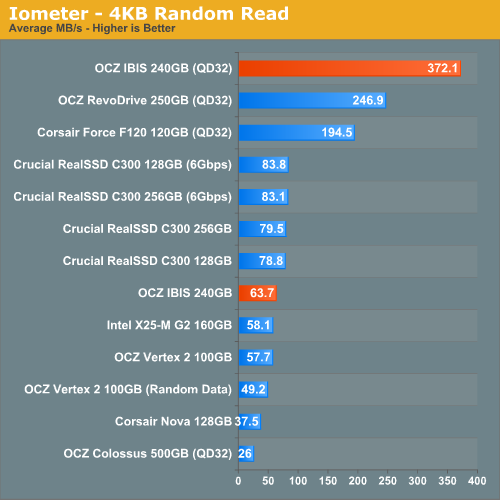OCZ's Fastest SSD, The IBIS and HSDL Interface Reviewed
by Anand Lal Shimpi on September 29, 2010 12:01 AM ESTMaking Random Performance Look Sequential
The four corners of SSD performance are as follows: random read, random write, sequential read and sequential write speed. Random accesses are generally small in size, while sequential accesses tend to be larger and thus we have the four Iometer tests we use in all of our reviews.
Our random tests write 4KB in a completely random pattern over an 8GB space of the drive to simulate the sort of random access that you'd see on an OS drive (even this is more stressful than a normal desktop user would see). Our random read test spans the entirety of the drive. I perform three concurrent IOs and run the test for 3 minutes. The results reported are in average MB/s over the entire time.

In case you didn't do the math in your head, 510MB/s of 4KB random writes translates to 130,000 IOPS. That's insane. The IBIS can deliver faster random writes than the RevoDrive can manage sequential writes. A fully taxed SandForce drive manages 200MB/s, the performance advantage here is huge. Again I can't stress enough how fast four of these things must be.

Random read performance across the drive's entire LBA space drops the peak performance a bit but we're still well beyond what 3Gbps SATA can deliver, although technically 6Gbps SATA would be enough here. You'll note that in a desktop workload (QD=3) there's no advantage to the IBIS drive. This thing really only makes sense for very I/O intensive workloads.










74 Comments
View All Comments
punjabiplaya - Wednesday, September 29, 2010 - link
If I understood this correctly, OCZ is just using PCIe signaling over a SAS cable (with accompanying card to demux and pass on to the PCIe lanes)? That's ingenious.davecason - Wednesday, September 29, 2010 - link
This method also makes it easy to port it to a laptop interface through an express card socket.vol7ron - Wednesday, September 29, 2010 - link
Isn't that what PCIe RAID controllers do (minus the SAS cable)?TinyTeeth - Saturday, October 2, 2010 - link
I'm pretty sure they communicate with regular SATA SSD drives through the SATA interface, whereas HSDL brings PCIe all the way to the SSD drive. This would be why IBIS supports much higher IOPS than previous PCIe SSD solutions like the Z-Drive (which were limited by SATA RAID). Someone please correct me if I'm wrong about this.Ethaniel - Wednesday, September 29, 2010 - link
675 MB/s in sequential write? I just feel sad all of a sudden. SSDs are so forbidden for me right now, but this is a true monster. Maybe they'll make a more "down-to-Earth" version next time. Good stuff, anyway.vol7ron - Wednesday, September 29, 2010 - link
If only I could burn DVDs that fast.Lerianis - Saturday, October 2, 2010 - link
You still burn DVD's? Hell, I stopped doing that a few months ago when I realized that 99% of the stuff I burned was really a 'watch-once and never again' thing and went out to get one of those 2.5" 1TB external hard drives.Haven't burned another DVD since.
rqle - Wednesday, September 29, 2010 - link
too much proprietary peripherals, if i am going to use a PCIe card, I might as well just stick with a revodrive. pcie slots, proprietary slots connectors, proprietary cable, proprietary disk drive interface, blah. ill just stick with their own revodrive for now and wait for sata or sas controllers to pick up speed.jo-82 - Wednesday, September 29, 2010 - link
SAS cabels aren't that expensive these days, and the most companies who would by one of these use them today anyway.And good luck waiting the next 3-5 years or so for SATA 12GB ;)
vol7ron - Wednesday, September 29, 2010 - link
Gb, not GB